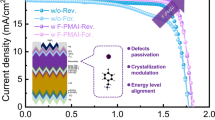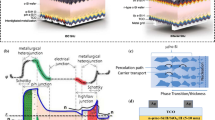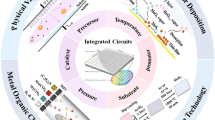Abstract
The next wave of Information technology is powered by Industry 4.0 which brings digital and physical technologies together to create interconnected operations. Sensors would be required to be embedded in physical objects to capture and stream data on a continuous basis. Energy harvesting is critical for these sensors, which need continuous supply of electricity for reliable transmission of data. Graphene/Silicon (Gr/Si) Metal–Insulator-semiconductor (MIS) solar cells are emerging to be the most suitable option for energy harvesting for applications in wireless sensor networks (WSN). But efficiency is constrained by surface defects and dangling bonds. High carrier recombination at the Silicon surface restricts enhancement w.r.t. open circuit voltage (Voc) and minority carrier lifetime (τeff). In this study, 6,13-bis (triisopropylsilylethynyl) (TIPS) pentacene, thin film is employed as electron blocking layer. The novelty of the work is the addition of the oxide layer between TIPS Pentacene and Silicon. This work simulates and verify experimentally, the passivation ability of TIPS Pentacene along with oxidation of Silicon surface. The band alignment between TIPS Pentacene and Silicon, increases the Schottky barrier height (SBH). Additional oxide layer saturates most of the dangling bonds at the Silicon surface. The average open circuit voltage (Voc) of the MIS silicon solar cell with combination of TIPS Pentacene and oxide layer, increases by ~ 6% as compared with that of only TIPS Pentacene layer. The minority carrier lifetime also enhances by ~ 6%. These solar cells can be manufactured with low temperature and safe chemical oxide passivation process for high efficiency and low cost WSN applications.













Similar content being viewed by others
References
Baeg K-J, Binda M, Natali D, Caironi M, Noh Y-Y (2013) Organic light detectors: Photodiodes and phototransistors. Adv Mater 25:4267–4295
Gelinck GH et al (2016) X-ray detector-on-plastic with high sensitivity using low cost, solution-processed organic photodiodes. IEEE Trans Electron Dev 63:197–204
Arca F, Tedde SF, Sramek M, Rauh J, Lugli P, Hayden O (2013) Interface trap states in organic photodiodes. Sci Rep 3:1324
Leem D-S et al (2013) Low dark current small molecule organic photodetectors with selective response to green light. Appl Phys Lett 103:043305
Song Y, Li X, Mackin C, Zhang X, Fang W, Palacios T, Zhu H, Kong J (2015) Role of interfacial oxide in high-efficiency graphene-silicon Schottky barrier solar cells. Nano Lett 15:2104–2110
Yang L, Yu X, Xu M, Chen H, Yang D (2014) Interface engineering for efficient and stable chemical-doping-free graphene-on-silicon solar cells by introducing a graphene oxide interlayer. J Mater Chem A 2:16877–16883
Aberle AG (2000) Surface passivation of crystalline silicon solar cells: a review. Prog Photovolt Res Appl 8:473–487
Liu J, Yao Y, Xiao S, Gu X (2018) Review of status developments of high-efficiency crystalline silicon solar cells. J Phys Appl Phys 51:123001–123007
Montenegro Benavides C, Biele M, Schmidt O, Brabec CJ, Tedde SF (2018) TIPS Pentacene as a Beneficial Interlayer for organic photodetectors in imaging applications. IEEE Trans Electron Dev 65:1516–1522
Perez MD, Borek C, Forrest SR, Thompson ME (2009) Molecular and morphological influences on the open circuit voltages of organic photovoltaic devices. J Am Chem Soc 131:9281–9286
He C, Zhong CM, Wu HB, Yang RQ, Yang W, Huang F, Bazan GC, Cao Y (2013) Conjugated zwitterionic polyelectrolyte-based interface modification materials for high performance polymer optoelectronic devices. J Mater Chem 20:1298–1307
Lim Y-F, Shu Y, Parkin SR, Anthony JE, Malliaras GG (2009) Soluble n-type pentacene derivatives as novel acceptors for organic solar cells. J Mater Chem 19:3049–3056
Davis RJ, Lloyd MT, Ferreira SR, Bruzek MJ, Watkins SE, Lindell L, Sehati P, Fahlman M, Anthony JE, Hsu JWP (2010) Determination of energy level alignment at interfaces of hybrid and organic solar cells under ambient environment. J Mater Chem 21:1721–1729
Wu S, Cui W, Aghdassi N, Song T, Duhm S, Lee S-T, Sun B (2016) Nanostructured Si/organic heterojunction solar cells with high open-circuit voltage via improving junction quality. Adv Funct Mater 26:5035–5041
Ruan K, Ding K, Wang Y, Diao S, Shao Z, Zhang X, Jie J (2015) Flexible graphene/silicon heterojunction solar cells. J Mater Chem A 3:14370–14377
Yadav TS, Sandeep K, Sharma AK, Spandana B, Narasimhan K, Arora B, Kottantharayil A, Basu PK (2017) A new low-cost and low-temperature chemical passivation process for large area industrial single crystalline silicon wafers. Proceedings of 44th IEEE Photovoltaic Specialist Conference
Chang HX, Sun ZH, Yuan QH, Ding F, Tao XM, Yan F, Zheng ZJ (2014) Tuning the nonlinear optical absorption of reduced graphene oxide by chemical reduction. Opt Express 22:19375–19385
Sentaurus User Guide, Version G-2012.06 (2012) Synopsis ©
Kern W, Soc JE (1990) The evolution of silicon wafer cleaning technology. J Electrochem Soc 137:1887–1892
Yadav TS, Sharma AK, Kottantharayil A, Basu PK (2018) Low-cost and low-temperature chemical oxide passivation process for large area single crystalline silicon solar cells. Sol Energy 169:270–276
Zirzlmeiera J, Lehnherrb D, Cotoc PB, Chernickd ET, Casillasa R, Basela BS, Thossc M, Tykwinskid RR, Guldia DM (2015) Singlet fission in pentacene dimers. PNAS 110:5325–5330
Funding
This work (fabrication and characterization) was carried out at the NCPRE, IITB under PUMP which is funded by MNRE, Government of India. Authors acknowledge the facilities and guidance extended to use fabrication and characterization facility available at NCPRE, IITB.
Author information
Authors and Affiliations
Corresponding author
Ethics declarations
Conflicts of interest
Authors declare that there are no known conflicts of interest associated with this publication.
Rights and permissions
About this article
Cite this article
Kaulgud, S., Sharma, R., Jolly, L. et al. Enhanced surface passivation with TIPS pentacene and additional interfacial layer for MIS solar cells. Int. j. inf. tecnol. 13, 1323–1330 (2021). https://doi.org/10.1007/s41870-021-00654-6
Received:
Accepted:
Published:
Issue Date:
DOI: https://doi.org/10.1007/s41870-021-00654-6




